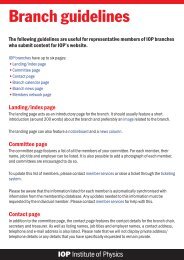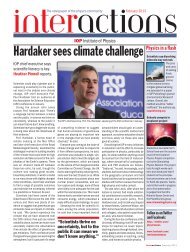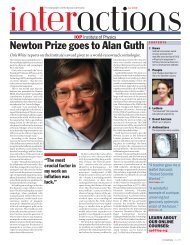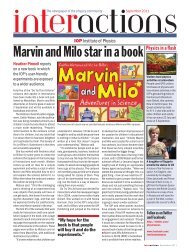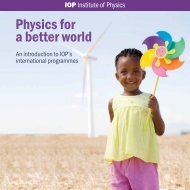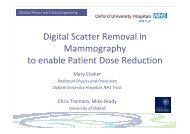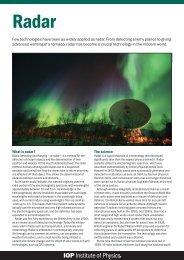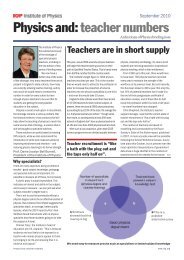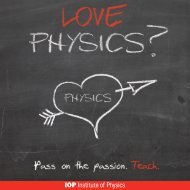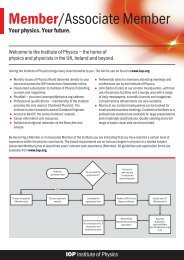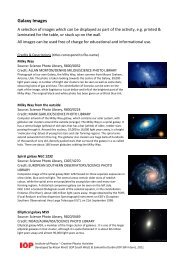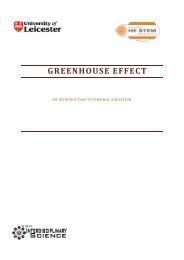Girls in the Physics Classroom: A Teachers' Guide - Institute of Physics
Girls in the Physics Classroom: A Teachers' Guide - Institute of Physics
Girls in the Physics Classroom: A Teachers' Guide - Institute of Physics
Create successful ePaper yourself
Turn your PDF publications into a flip-book with our unique Google optimized e-Paper software.
Introduction<br />
Introduction<br />
In 2005 physics was <strong>the</strong> 12th most-popular A-level <strong>in</strong> <strong>the</strong><br />
UK, with 28 119 candidates. Of <strong>the</strong>se, 21 922 were male,<br />
mak<strong>in</strong>g physics <strong>the</strong> sixth most-popular A-level subject for<br />
boys beh<strong>in</strong>d maths (32 719), general studies (28 083),<br />
English (26 332), history (22 342) and biology (22 046).<br />
For girls, physics was <strong>the</strong> 19th most-common A-level<br />
choice. Of those who took physics A-level, 34% achieved<br />
an A grade. In 2005 only 14% <strong>of</strong> girls who were awarded<br />
an A* or A for GCSE Double Award Science or <strong>Physics</strong> sat<br />
A-level physics. In o<strong>the</strong>r words <strong>the</strong>re is a very substantial<br />
number <strong>of</strong> girls who have <strong>the</strong> ability to do well at physics<br />
but who are choos<strong>in</strong>g not to study <strong>the</strong> subject post-16.<br />
The low uptake is not a new problem; figure 1 shows <strong>the</strong><br />
proportions <strong>of</strong> girls and boys study<strong>in</strong>g physics between<br />
1995 and 2005. For physics teachers this decrease is dishearten<strong>in</strong>g.<br />
For <strong>the</strong> UK it is a very serious problem because<br />
A-level physics is a gateway qualification to a variety <strong>of</strong><br />
careers that make a substantial contribution to <strong>the</strong> f<strong>in</strong>ancial<br />
and <strong>in</strong>tellectual wealth <strong>of</strong> <strong>the</strong> country.<br />
In 2004 <strong>the</strong> <strong>Institute</strong> <strong>of</strong> <strong>Physics</strong> commissioned two<br />
pieces <strong>of</strong> work about girls’ engagement with physics:<br />
● Yes She Can 1 is an <strong>in</strong>vestigation by Bob Ponchaud<br />
(ex-HMI for science) <strong>in</strong>to schools that are successful at<br />
attract<strong>in</strong>g girls to study A-level physics and how this<br />
might <strong>in</strong>form o<strong>the</strong>r schools.<br />
● <strong>Girls</strong> <strong>in</strong> <strong>the</strong> <strong>Physics</strong> <strong>Classroom</strong>: a Review <strong>of</strong> <strong>the</strong><br />
Research on <strong>the</strong> Participation <strong>of</strong> <strong>Girls</strong> <strong>in</strong> <strong>Physics</strong> 2 by<br />
Patricia Murphy and Elizabeth Whitelegg <strong>of</strong> <strong>the</strong> Open<br />
University aims to consolidate current understand<strong>in</strong>g<br />
<strong>of</strong> <strong>the</strong> problem and to identify from exist<strong>in</strong>g research<br />
<strong>the</strong> reasons why girls choose not to cont<strong>in</strong>ue study<strong>in</strong>g<br />
physics. It also identifies <strong>the</strong> strategies that have<br />
succeeeded <strong>in</strong> <strong>in</strong>creas<strong>in</strong>g <strong>the</strong> number <strong>of</strong> girls study<strong>in</strong>g<br />
physics post-16.<br />
The reports reveal some <strong>of</strong> <strong>the</strong> important issues that underlie<br />
<strong>the</strong> statistics for exam<strong>in</strong>ation entries:<br />
● It cannot be assumed that, <strong>in</strong> <strong>the</strong> current National<br />
Curriculum provision, all students, <strong>in</strong> particular girls,<br />
are ga<strong>in</strong><strong>in</strong>g mean<strong>in</strong>gful access to physics.<br />
● Students’ <strong>in</strong>terest <strong>in</strong> science decl<strong>in</strong>es as <strong>the</strong>y progress<br />
through school and <strong>the</strong> decl<strong>in</strong>e appears to become<br />
steeper after age 14, particularly for girls and<br />
particularly <strong>in</strong> physics.<br />
● <strong>Girls</strong>, more than boys, experience a difference between<br />
<strong>the</strong>ir personal goals for learn<strong>in</strong>g and <strong>the</strong> learn<strong>in</strong>g<br />
objectives <strong>of</strong> <strong>the</strong> physics curriculum. As a<br />
consequence <strong>the</strong>y are less <strong>in</strong>cl<strong>in</strong>ed to opt for physics,<br />
even if <strong>the</strong>y achieve high grades and enjoy <strong>the</strong> subject.<br />
● As <strong>the</strong>y go through secondary school<strong>in</strong>g, students<br />
I NSTITUTE OF P HYSICS R EPORT G IRLS IN THE P HYSICS C LASSROOM: A TEACHERS’ GUIDE FOR A CTION D ECEMBER 2006<br />
number <strong>of</strong> candidates<br />
30000<br />
25000<br />
20000<br />
15000<br />
10000<br />
5000<br />
males<br />
females<br />
0<br />
1995 1996 1997 1998 1999 2000<br />
year<br />
2001 2002 2003 2004 2005<br />
experience physics to be <strong>in</strong>creas<strong>in</strong>gly difficult. This<br />
perception is partly due to <strong>the</strong> ma<strong>the</strong>matical demands<br />
<strong>of</strong> <strong>the</strong> subject but also to girls’ develop<strong>in</strong>g feel<strong>in</strong>g <strong>of</strong> “not<br />
be<strong>in</strong>g able to do physics”. The feel<strong>in</strong>g is not borne out<br />
by <strong>the</strong> reality <strong>of</strong> girls’ performance.<br />
The two reports have found that key <strong>in</strong>fluences on students’<br />
attitudes to physics are:<br />
● self-concept (i.e. students’ sense <strong>of</strong> <strong>the</strong>mselves <strong>in</strong><br />
relation to <strong>the</strong> subject : <strong>the</strong> value <strong>the</strong>y place on <strong>the</strong><br />
subject and <strong>the</strong>ir will<strong>in</strong>gness to engage <strong>in</strong> it);<br />
● views <strong>of</strong> physics (i.e. how students experience physics<br />
at school);<br />
● teacher-student relationships (i.e. how personally<br />
supportive students f<strong>in</strong>d <strong>the</strong>ir physics teacher).<br />
This guide draws on <strong>the</strong> work done by Ponchaud, and by<br />
Murphy and Whitelegg, to identify some <strong>of</strong> <strong>the</strong> strategies<br />
that schools could use to try to <strong>in</strong>crease <strong>the</strong> participation <strong>of</strong><br />
girls <strong>in</strong> post-16 physics:<br />
● Section 1 is written by Ponchaud. It explores <strong>the</strong><br />
lessons that he learned from schools that are<br />
successfully recruit<strong>in</strong>g girls to AS physics, reta<strong>in</strong><strong>in</strong>g<br />
<strong>the</strong>m <strong>in</strong>to A2 and ga<strong>in</strong><strong>in</strong>g good exam<strong>in</strong>ation results. It<br />
also suggests how this good practice can be<br />
developed <strong>in</strong> o<strong>the</strong>r schools.<br />
● Section 2 is written by Murphy and Whitelegg. It<br />
summarises <strong>the</strong> research f<strong>in</strong>d<strong>in</strong>gs and suggests<br />
practical ways that you can exam<strong>in</strong>e <strong>the</strong>se issues <strong>in</strong><br />
<strong>the</strong> context <strong>of</strong> your school, department or classroom.<br />
● Section 3 is written by Mart<strong>in</strong> Holl<strong>in</strong>s. It is based on two<br />
videos: Sav<strong>in</strong>g Nellie and Key Stage 3/4 Science: <strong>Girls</strong><br />
Fig. 1: Number <strong>of</strong><br />
A-level physics<br />
candidates.<br />
1. Yes She Can has not previously<br />
been published but it forms <strong>the</strong><br />
basis for section 1 <strong>of</strong> this report.<br />
2. Murphy P and Whitelegg E<br />
2006 <strong>Girls</strong> <strong>in</strong> <strong>the</strong> <strong>Physics</strong><br />
<strong>Classroom</strong>: a Review <strong>of</strong> <strong>the</strong><br />
Research on <strong>the</strong> Participation <strong>of</strong><br />
<strong>Girls</strong> <strong>in</strong> <strong>Physics</strong>, <strong>Institute</strong> <strong>of</strong><br />
<strong>Physics</strong>.<br />
1



